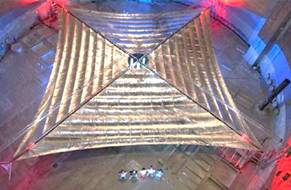MAS Teams with L'Garde on NASA Technology Demonstration Mission

Micro Aerospace Solutions (MAS) has teamed with L'Garde Inc. of Tustin, California on a NASA Technology Demonstration mission to demonstrate propellant-less navigation on a deep space mission. This sail technology has the potential to revolutionize in-space propulsion by accelerating spacecraft using solar energy, much like a sailboat uses wind. Thus, the spacecraft does not need to carry propellant. Previously the amount of propellant carried by a spacecraft limited the lifetime of a vehicle. Development of solar sail technology opens the door to propelling deep space missions, working towards manned missions. This technology demonstration is scheduled to launch by late 2014.
NASA selected the MAS-L'Garde team as one of three winners out of 47 proposals received, and was the most commercially oriented winning proposal. Affordability was one of the factors in the agency's decision on which projects to award funding. MAS will provide spacecraft component selection, pointing, guidance, power systems, control and communication for the solar sail to prime contractor L'Garde.
The ultra-thin solar sail will be seven times larger than ever flown in space before. "One reason our mission was selected was the commercial involvement. Using technology developed for very small satellites and taking advantage of these advancements allows us to fly this mission for one tenth of what it would have previously cost," said MAS President Don Platt.
Micro Aerospace Solutions, Inc. is a small business in Melbourne, Florida that was established in 2000. MAS has involvement in a number of small satellite and space-based software development and flight projects. These projects include small satellites and cubesat systems for government, industry and university partners. Small satellites and cubesat systems are small, reliable, and cost effective miniature versions of full scale satellites that take advantage of development of miniature electronics and standardized commercial off-the-shelf hardware. This allows us to do more in space for a lower cost. Using this process also allows us to provide low cost services in other areas such as improvements in medical and pharmaceuticals, and making STEM educational activities more accessible to the general public.
Kara Schmitt, Vice President of Research and Development, states "The new possibilities of small satellite products really have the opportunity to shine here. This is an exciting project for us, and we're looking forward to working with the prime contractor to showcase the "innovation" of small satellite hardware to successfully meet mission goals of propulsion using a solar sail. The implications for deep space missions are that they are no longer being constrained by how much propellant it can carry, or how far it can go. This will extend mission lifetime in a very exciting way."

